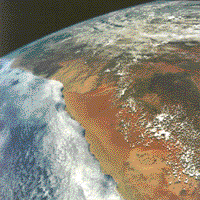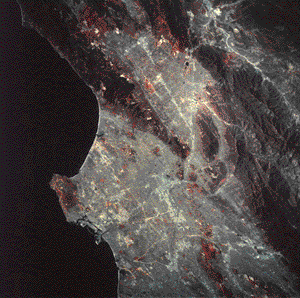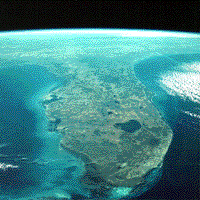
 Part 1 of 8
Part 1 of 8



The Ultimate Field Trip
An Astronaut's View of Earth
by Kathryn D. Sullivan, Ph.D.
NASA Astronaut
 |
Namib Desert [STS035-602-024]
The cloud bank that often hugs the coast of southwest Africa never drops rain on the Namib
Desert. But this coastal fog, produced by the temperature inversion
over the cold Benguela Current, frequently does penetrate the
valleys between the dunes. Recent studies indicate that tiny
flora and fauna have adapted to this "wet desert" by
developing mechanisms for retrieving their water supply from the
fog. Lacking such mechanisms, human beings have died of thirst
on this mountain-backed desert. Some of them were hunting for
diamonds deposited in these sands by geological processes that
remain a mystery. Their bones, the bones of shipwrecked sailors,
or more likely, the spars of their ships gave rise to the name
"Skeleton Coast." The skeletons may even have been
those of whales washed ashore. But it was not the rib-like dunes
that evoked the name; this portion of the coast of Africa was
called the Skeleton Coast long before such synoptic views as this
were possible.
|
Why does someone who is nearing the end of 9 years of professional
preparation as a marine geologist turn away from the sea for a
Government aerospace job? In my case, it was because the job
was offered by NASA and held the almost incredible possibility
of getting to see our home planet from space with my own eyes.
In my mind, this was an opportunity no self-respecting Earth
scientist and explorer could pass up, so all the complex questions
usually involved in a major career change seemed quite simple.
After 13 years and two flights (or 209 revolutions and 4.8 million
miles), the wisdom of my course change is confirmed.

|
Kathy Sullivan's Hometown [STS039-89-062]
If you know your geography, you can track waterways and highways, parks and
airports, mountain peaks and city streets to locate your hometown
in a view from the Space Shuttle. In this color infrared view
of the Los Angeles Basin, you can follow the San Diego Freeway
from the Naval Station at Long Beach, past Los Angeles International
Airport and Marina del Rey, through the Santa Monica Mountains,
to the Ventura Freeway just south of the Sepulveda Dam Recreation
Area (the reddish patch in the San Fernando Valley); turn left
and go past Tarzana to the intersection with Topanga Canyon Blvd.;
this is the place our astronaut author calls home: Woodland Hills,
CA.
|
My role as a Mission Specialist aboard the Space Shuttle
gives me two exciting avenues for exploration on each mission.
On the one hand, I conduct experiments or observations on behalf
of a large team of scientists and engineers on the ground, in
essence serving as their hands, eyes, and ears in orbit. In many
respects I become part of the investigating team, sharing with
them the excitement of the science and the challenge of planning
and executing a complex mission. There's also a great responsibility
here, however, since space flights are unique and expensive scientific
opportunities. When an event or observation occurs only once
during a flight, the procedure must be done correctly the first—and
only—time. A tremendous amount of training and preparation
is devoted to ensuring that all our procedures are correct and
that we are proficient at performing them. We also train ourselves
to get the job done on orbit even if one or two things have gone
wrong; you can't give up easily in the space business.

|
Well-Known Peninsula [STS51C-44-026]
You don't have to be a good geography student to recognize Florida in this astronauts'
view of their launch site. Cape Canaveral is the spit on the
Atlantic coast. Straight inland from it, within the central chain
of lakes, is Disney World. And on the Gulf side of the state
is Tampa Bay. The lakes are hollowed-out low spots in the limestone
that was laid down beneath an ancient sea. Such sinkholes in
this "karst" topography continue to open up, occasionally
swallowing houses. The chain of lakes culminates in the huge
Lake Okeechobee. You can see a large agricultural area (Florida
oranges?) just to the south of it. The surrounding Everglades
(where the alligators roam) lead us to Miami in the foreground.
|
The second avenue of exploration is quite different from
the first. Instead of the tremendous professional satisfaction
I get from succeeding at the formal tasks specified in my flight
plan, this one returns much more personal pleasure and insight.
I'm referring, of course, to the experience that originally
motivated me to apply to NASA: looking out my "office"
window at the Earth below.

 Part 1
Part 1


 Office of Earth Sciences Homepage
Office of Earth Sciences Homepage
 Earth Science and Solar System Exploration Division page.
Earth Science and Solar System Exploration Division page.
 Earth Observations and Imaging Newsletter
Earth Observations and Imaging Newsletter
Recommended citation (MLA-Style): Sullivan, K. D. 9 August 1995. "The Ultimate
Field Trip: An Astronaut's View of Earth, "Earth Observations and Imaging Newsletter,
Office of Earth Sciences, NASA Johnson Space Center. <http://eol.jsc.nasa.gov
/newsletter/uft/uft1.html>
This local copy was downloaded from
http://eol.jsc.nasa.gov/newsletter/uft/uft1.html on 18 Jan 2000.
Notices: What You Need to Know About NASA JSC Web Policies
Responsible NASA official: Dr. Kamlesh Lulla
Curator: James Heydorn

 Part 1 of 8
Part 1 of 8




 Part 1 of 8
Part 1 of 8







 Part 1
Part 1

